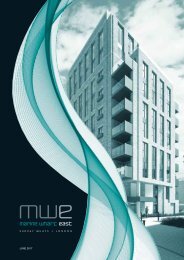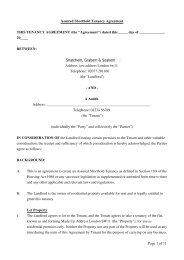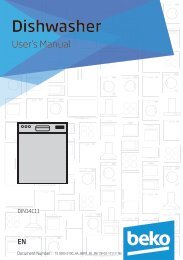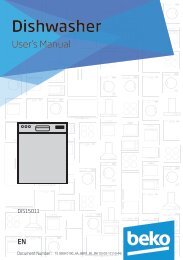Ei140RC-Series-Instuctions-Rev2
Create successful ePaper yourself
Turn your PDF publications into a flip-book with our unique Google optimized e-Paper software.
• Near a decorative object, door, light fitting, window<br />
moulding etc., that may prevent smoke or heat from<br />
entering the Alarm.<br />
• Surfaces that are normally warmer or colder than the rest of<br />
the room (e.g. attic hatches). Temperature differences might<br />
stop smoke or heat from reaching the unit.<br />
• Next to or directly above heaters or air conditioning vents,<br />
windows, wall vents etc. that can change the direction of<br />
airflow.<br />
• In very high or awkward areas (e.g. over stairwells) where<br />
it may be difficult to reach the alarm (for testing, hushing<br />
or battery replacement).<br />
• Locate away from very dusty or dirty areas as dust build-up<br />
in the chamber can impair performance. It can also block the<br />
insect screen mesh and prevent smoke from entering the<br />
smoke detector chamber.<br />
• Locate the unit at least 1m from dimmer controlled lights<br />
and wiring as some dimmers can cause interference.<br />
• Locate unit at least 1.5m and route wiring at least 1m away<br />
from fluorescent light fittings as electrical “noise” and/or<br />
flickering may affect the unit. Do not wire into the same<br />
circuit as fluorescent lights or dimmers.<br />
• Do not locate in insect infested areas. Small insects getting<br />
into the smoke detector chamber can cause intermittent<br />
alarms. Insects and contamination on the Heat Alarm<br />
sensor can increase its response time.<br />
Installation<br />
The Alarm is designed to be permanently mounted,<br />
using it’s own built-in terminal block to connect it to the<br />
mains. The mounting plate can be screwed directly to<br />
the ceiling. Alternatively it can be screwed to a standard<br />
junction box. It requires a current of 40mA. The Alarm<br />
must not be exposed to dripping or splashing. There are<br />
important markings on the underside of the alarm.<br />
Caution<br />
Alternative Energy Sources - (Wind, Solar, UPS etc.)<br />
This product is designed to be connected to a Pure or<br />
True Sine Wave 230 Vac supply.<br />
If connecting to a power source that utilises an inverter,<br />
e.g. PV solar panel, the Total Harmonic Distortion (THD)<br />
must be less than 5%. If in doubt please check with the<br />
manufacturer of the inverter.<br />
This also applies to battery powered UPS (Uninterruptible<br />
Power Supply) inverters.<br />
Light Dimmer Circuits – The Alarms must not be<br />
powered from a light dimmer circuit.<br />
IMPORTANT PRECAUTION: Do not install the<br />
Alarms in new or renovated buildings until all work<br />
is completed (including floor coverings) and the<br />
building has been fully cleaned. The wiring can be<br />
installed when appropriate. (Excessive dust and<br />
debris from building work can contaminate the<br />
smoke chamber or heat sensor and cause problems,<br />
it will also invalidate the guarantee). If it must<br />
be installed, first cover it completely, particularly<br />
around the edges, with a dust cover (eg. with the<br />
elasticated cover supplied or a plastic bag), until all<br />
cleaning is finished.<br />
The Alarm must not be connected when the house wiring<br />
insulation is being checked with high voltages. i.e. Do<br />
not use a high voltage insulation tester on the alarm.<br />
17
















